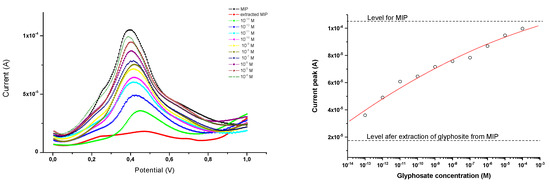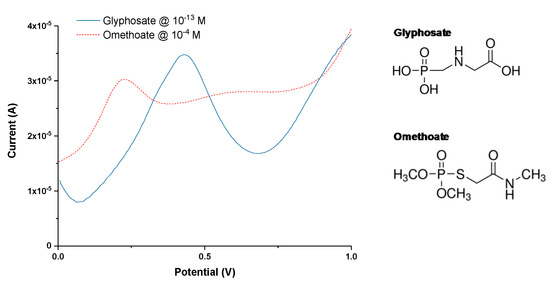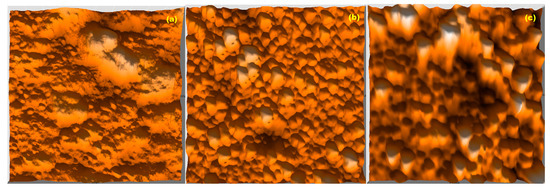Abstract
This study concerns the development of two molecularly imprinted polymers (MIP) based electrochemical sensors for glyphosate detection. In both cases polypyrrole (PPy) was chosen as matrix and glyphosate molecules were the templates. The main difference between the two strategies is related to the investigated electrode: gold surface in the first case, and ZnO nanorods vertically grown on ITO diazonium modified substrates in the second case. The limits of detection (LOD) of these sensors were about 10−13 M and 10−10 M respectively.
1. Introduction
Glyphosate is the most frequently used herbicide worldwide. Its hazard potential is unclear, as it possesses amino acid-like structures which might interfere with the formation of amino acids and other chemicals in plants. Among the major concerns, glyphosate was found to affect the human hormonal system, chromosomal changes, tumors in the pancreas, and increased risk of skin cancer [1]. These health concerns have motivated the development of numerous analytical methods to track glyphosate in the environment as well as in body fluids. Despite their highly sensitive and accurate detection, many of the developed methods are costly, complicated, time-consuming or require extensive instrumentation.
An interesting alternative approach consists in the design of molecularly imprinted polymer (MIP) based electrochemical sensors [2,3] for the selective detection of glyphosate. The rationale for making MIPs, is that they are low-cost, sensitive and powerful analytical tools capable of determining low concentrations of this herbicide, inferior to the limits required by the European standards (EU limit in drinking water is 0.1 μgL−1 (5.9 × 10−10 M) [4].To achieve high sensitivities and low limits of detection, a promising route consists in increasing the specific surface area of the sensors by incorporating ZnO nanorods, which have ultra-high surface/volume ratio, and coating them with the PPy-MIP [5,6].
2. Materials and Methods
2.1. Chemicals
Pyrrole, lithium perchlorate, glyphosate, omethoate, methanol (MeOH), acetic acid (AcCOOH) H2SO4 (95%) and H2O2 (30%), zinc acetate dihydrate (Zn(CH3COO)2 2H2O, 99.99% of purity), sodium hydroxide (NaOH, purity ≈ 97%), hexamethylenetetramine (C6H12N4, 99% purity) and ITO electrodes were purchased from Sigma Aldrich. Absolute ethanol was supplied by VWR Prolabo; Zinc nitrate hexahydrate (Zn(NO3)2, Purity ≈ 99%) was from Merck. Pyrrole was purified before its use by filtering through basic alumina column and stored in dark under argon at −4 °C. Lithium perchlorate was used as a supporting electrolyte for electrochemical measurements. Glyphosate and omethoate were used as received.
2.2. Electrochemical Measurements
Electrochemical measurements were performed at room temperature with a CHI 650electrochemical workstation. A conventional three-electrodes system was used with a steel grid, a saturated calomel, and gold (or ITO) substrates as auxiliary, reference and working electrodes respectively.
2.3. Atomic Force Microscopy
Atomic force microscopy measurements were carried out at room temperature, with a Nanosurf (Liestal, Switzerland) easyScan 2 Flex AFM system in the dynamic force mode, with cantilever’s resonance frequency of about 165 kHz. Commercially available tips with typical curvature radius of6 nm were used (ACLA silicon AFM probes, from AppNANO, Mountain View, CA, USA).
2.4. Design of MIP Based Senors
Two routes were investigated to design the MIP based sensors (Figure 1). Prior to any electrochemical process, the working electrodes were cleaned and activated by a drop of a piranha solution (98% H2SO4/30% H2O2 1:1 V/V), during 20min.

Figure 1.
Schematic representation of MIPs preparation (a) PPy electropolymerized MIP and (b) ZnO-MIP based sensors.
For the first route, the films were electrodeposited by chronoamperometry (CA) to control their growth. A thin polypyrrole blocking layer was deposited by CA before MIP electrosynthesis to prevent the formation of glyphosate complexes with gold electrodes (Figure 1a).
In the second strategy, MIP coated ZnO nanorods were considered to attempt enhancement of sensitivity to glyphosate. ZnO nanords were prepared as follow [7]: first, 75mM of zinc acetate were mixed homogenously and stirred during 6h at 75°C with 100mM of NaOH in 75mL of ethanol to obtain ZnO nanoparticles which were deposited by spin coating on Gold (ITO) surfaces modified by diazonium salts. The further growth step was carried out by immersing the electrodes in a beaker which contains 500mL of water, 30mM of zinc nitrate hexahydrate and 30mMof hexamethylenetetramine (HMT). The mixture was heated up to 95 °C and stirred for 5 h. Finally, the samples were rinsed with deionized water and dried at 120 °C.
3. Results and Discussion
3.1. Electrochemical Measurements
Square wave voltammetry (SWV) was used to record the sensors response to glyphosate at different concentrations varying from10−13M to 10−4M. Results presented in Figure 2 indicate that the current peaks values increase with glyphosate concentration and that the peak corresponding to the lowest concentration remains clearly distinguishable, with respect to the response to the blank. This value is three orders of magnitude lower than the limit value set by the EU for drinking water.

Figure 2.
Follow up of glyphosate concentration variation, by square wave voltammetry (left), and current variation versus glyphosate concentration (right).
Selectivity tests were performed with omethoate, an organophosphorous pesticide widely used in the EU. Figure 3 shows that the sensors’ response for omethoate at concentration as high as 10−4M is comparable to that for glyphosate at concentration of 10−13M. These results are encouraging and other pesticides are under test.

Figure 3.
Current variation versus potential corresponding to glyphosate and omethoate detection by MIP based sensor (left); chemical structure of the two pesticides (right).
3.2. New Route and Perspectives
To reach high sensitivities and low LOD values, we chose to increase the specific surface area of the MIP by incorporating ZnO nanorods, due to their ultra-high surface/volume ratio. The preliminary experiments show that is possible to create nucleation sites on nonflexible electrodes (ITO or gold) for vertical growth of ZnO nanorods (Figure 4c). Nevertheless, by coating ZnO nanorods electrochemically with PPy-glyphosate-MIP, we do not reach the expected enhancement of sensors’ metrological performances. Indeed, the LOD obtained in this case, of about 10−10M, is in the same order of magnitude as the EU recommendations but largely superior to that obtained with the first strategy (10−13M).The main reasons lye in the distribution density and inclination of the ZnO nanorods, as shown in AFM images (Figure 4c). Optimization of these crucial parameters and nanorod spacing, essential for significant improvement of the sensors performances.

Figure 4.
AFM images (3×3 µm2) of (a) bare ITO electrode; (b) After deposition of ZnO nanoparticles; (c) after further ZnO nanorods growth.
Acknowledgments
N. Yaakoubi thanks “la région Pays de la Loire” for the financial support through the “LMAC/ MEMSAW project”.
Conflicts of Interest
The authors declare no conflict of interest. The founding sponsors had no role in the design of the study; in the collection, analyses, or interpretation of data; in the writing of the manuscript, and in the decision to publish the results.
References
- Portier, C.J.; Armstrong, B.K.; Baguley, B.C.; Baur, X.; Belyaev, I.; Budnik, L.T. Differences in the carcinogenic evaluation of glyphosate between the International Agency for Research on Cancer (IARC) and the European Food Safety Authority (EFSA). J.Epidemiol. Community Health. 2016, 70, 741–745. [Google Scholar] [CrossRef] [PubMed]
- Ktari, N.; Fourati, N.; Zerrouki, C.; Ruan, M.; Seydou, M.; Barbaut, F.; Nal, F.; Yaakoubi, N.; Chehimi, M.M.; Kalfat, R. Design of a polypyrrole MIP-SAW sensor for selective detection of flumequine in aqueous media. Correlation between experimental results and DFT calculations. RSC Adv. 2015, 5, 88666–88674. [Google Scholar] [CrossRef]
- Maouche, N.; Ktari, N.; Bakas, I.; Fourati, N.; Zerrouki, C.; Seydou, M.; Maurel, F.; Chehimi, M.M. A surface acoustic wave sensor functionalized with a polypyrrole molecularly imprinted polymer for selective dopamine detection. JMR 2015, 28, 667–678. [Google Scholar] [CrossRef]
- The EU-MRLs set in Regulation (EC) No 396/2005 from the European Union pesticide database. Available online: http://ec.europa.eu/sancopesticides/public/index.cfm (accessed on 9 June 2017).
- Liu, A.; Yin, K.; Li Mi, L.; Ma, M.; Liu, Y.J.; Li, Y.; Wei, W.; Zhang, Y.J.; Liu, S. A novel photoelectrochemical immunosensor by integration of nanobody and ZnOnanorods for sensitive detection of Nucleoside diphosphatase kinase-A. Anal.Chim.Acta 2017. [Google Scholar] [CrossRef]
- Ahmad, R.; Ahn, M.-S.; Hahn, Y.-B. ZnO nanorods array based field-effect transistor biosensor for phosphate detection. J. Colloid Interface Sci. 2017, 498, 292–297. [Google Scholar] [CrossRef] [PubMed]
- Mekki, A.; Ait-Touchente, Z.; Samanta, S.; Singh, A.; Mahmoud, R.; Chehimi, M.M.; Aswal, D.K. Polyaniline-Wrapped ZnO Nanorod Composite Films on Diazonium-Modified Flexible Plastic Substrates. Macromol. Chem. Phys. 2016, 217, 1136–1148. [Google Scholar] [CrossRef]
Publisher’s Note: MDPI stays neutral with regard to jurisdictional claims in published maps and institutional affiliations. |
© 2017 by the authors. Licensee MDPI, Basel, Switzerland. This article is an open access article distributed under the terms and conditions of the Creative Commons Attribution (CC BY) license (https://creativecommons.org/licenses/by/4.0/).